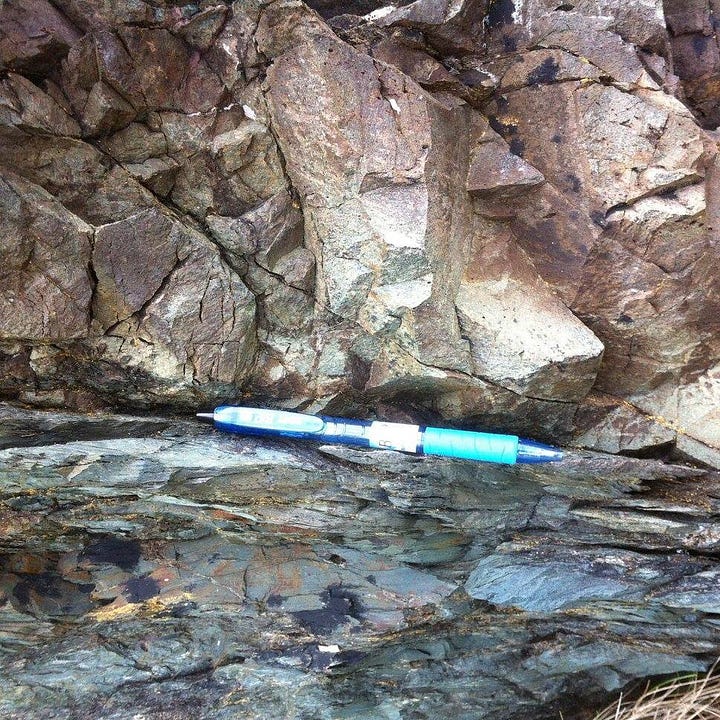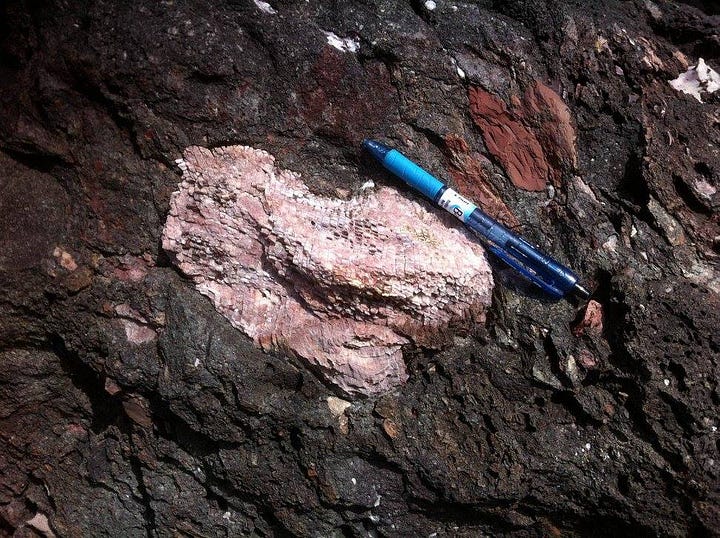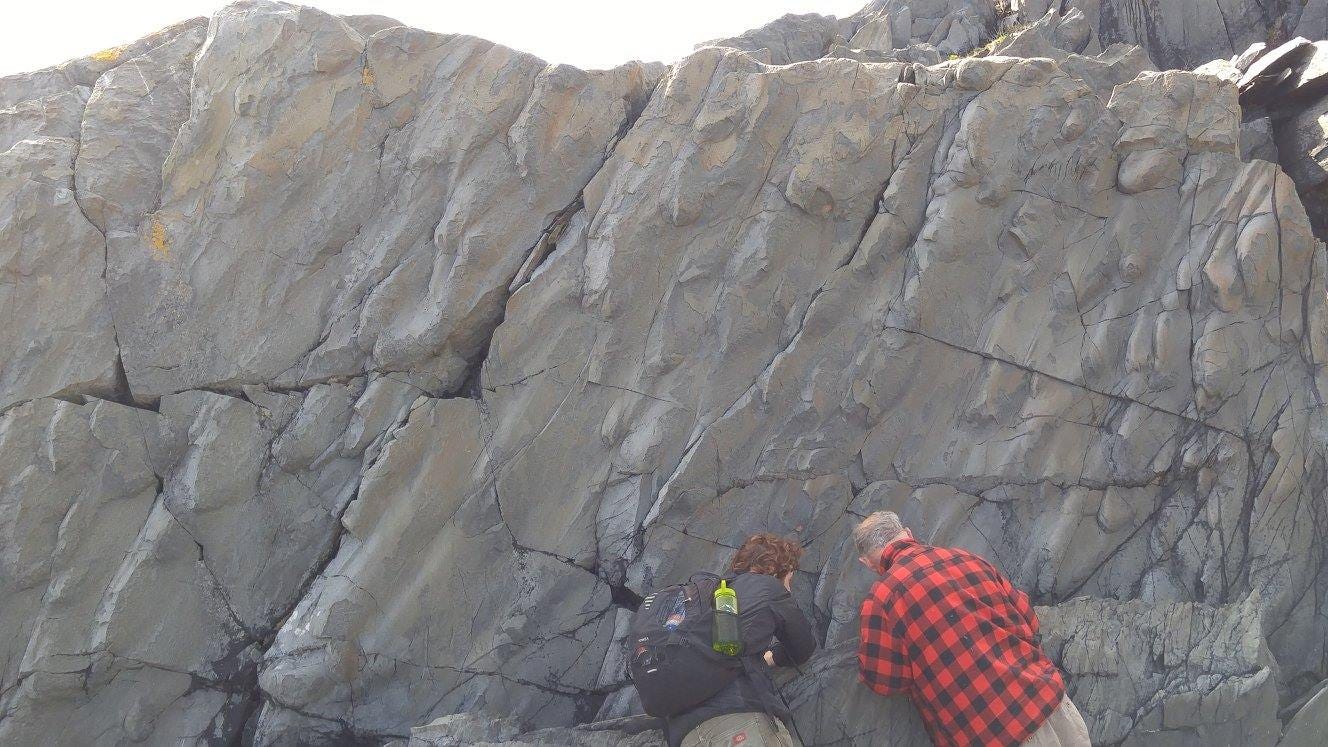One of my first geology professors was an aging, gesticulating man well known for his wild use of laser pointers and his odd digressions about race-walking and the local planning board. Like many of the old, greying white men whose classes I would attend over my undergraduate and graduate studies, Dr. E. was as historical as his chosen profession. It was quite fitting, then, that I would be his student for the first time in the last historical geology class he would ever teach before his retirement, a class that introduced me both to the nomenclature of the Earth and the stratigraphy of one of its long-time practitioners.
Many students of geology do not start off as geologists. I too was introduced to the field at the college-level, in my case, as an English major who had always been inclined towards language and narrative. Sitting in Dr. E.’s class on the first day, as he walked in wearing a red flannel coat and hunter cap, the remnant fires of the plate tectonics revolution still emanating from his bones, I felt uncertain about my decision. I was eighteen at the time and felt considerable pressure to study something “practical” in college rather than deal with constant questions of “so what are you going to do with it”. At the very least, I could convince myself that geology was far more employable. Yet, as it turns out, employability was never my real concern in college, and despite how much I tried to think in terms of job prospects and salaries, Dr. E.’s history of the Earth was far more compelling.
Our lectures often consisted of dusty, 35-millimeter slide decks from at least the 1970s, outdated overhead projector transparencies, and personal digressions on a variety of subjects. Everything felt as worn as the rural Maine town where I learned to read the Earth, surrounded by what remained of old, crumbling industry and the odd intersection between the blue collar, matter-of-fact world I grew up in, and the quirky, unassuming intellectual culture I came of age in. Dr. E. would spend class moving through the various slides on an old projector, showing us grainy pictures of outcrops from Newfoundland where he did research for his doctorate. I would sometimes fall asleep during these presentations, not necessarily out of boredom, often waking up to find Dr. E. asking the class questions about cross-bedding, punctuated equilibrium, and the Big Bang. He was always a stickler for what he termed “good questions,” becoming exasperated when our quiet class was hesitant to identify the sedimentary structures in those grainy outcrop photos and associate them with a depositional environment. The difference between molds and casts was a particular favorite of his, and Dr. E. would go to great lengths to test our understanding of this fundamental concept. In this pursuit, he would always end up showing us a photo of his favorite outcrop from his dissertation field area, a grey sandstone cliff on the Change Islands of Newfoundland (Figures 1, 3) with beautiful flute casts at the base of the bedding.


It soon became clear to me that Dr. E.’s historical geology class was a course on stratigraphy and sedimentology, his specialty, disguised as a survey of Earth history. Everything came back to sedimentary structures, whether we talked about the primordial soup or Dr. E.’s storied military career or the local planning board, everything circled back to those grainy 35-millimeter slides and the cross-bedding, mud cracks, and raindrop impressions we could barely make out. The fact that our class still couldn’t seem to remember what these were was a source of great frustration for Dr. E., once to the point where he stopped the class outright in a bout of exasperation. Dr. E. was the oldest teacher I had ever had, and it became clear to me that as the final class he would ever teach, he wanted more from us in that particular way aging academics from bygone times do.
As the old man waved his arms around, using phrases like “your generation doesn’t understand” and “back in my day”, he began to tell us a story, one that I have not since forgotten. It centered around juxtaposition, both a fundamental geologic concept and something deeply personal to Dr. E.’s life. In geology, juxtaposition reminds us that the worlds we inhabit are ephemeral places subject to change over the span of deep time. Across stratigraphic horizons, we witness the development of ice sheets, the birth and closure of oceans (Figure 2), the assembly of continents, and the great faunal successions that define the evolution of life on Earth. All of this is we encounter in the constancy of the everyday, making sense of it in terms of our limited temporal perceptions. For Dr. E., juxtaposition was his father, a strict man who expressed love in terms of discipline and struggle. Dr. E. explained to us that in a moment of great frustration, his father took his hands and forced them together, screaming “Juxtaposition!” as a means to teach him a hard lesson about life. I do not remember the exact details of this particular digression, but all I can remember is how vulnerable it all felt. I remember him admitting in a softer, more reflective tone that his father had been hard on him, sometimes abusive. The tone of his voice made it sound like it was something he had held for his entire life, and perhaps something he was still making peace with.
To understand the geology of a given locality is to understand its story, to apply a certain kind of textual analysis to the Earth that transforms something as imperceptible as deep time into narrative, the only reliable form of understanding we may ever have. While Dr. E.’s final class at first glance may have seemed like an old man trying to dispense the last bits of wisdom he could before his faculties declined, his stories and digressions found themselves interwoven with the story he was telling us about the Earth. A geologist teaching geology in the purest form it could be taught, the underpinnings of an entire discipline revealed through the scattered pedagogy of a graying old man. In Dr. E.’s class, the practice of science was also the practice of narrative, and whatever artificial separation existed between the two was rendered null and void. Cambrian, Ordovician, Silurian, he would say, expecting us to continue through the periods of the Paleozoic, an old man reflecting on what had departed him, all of it hidden between the eons and eras and epochs of geologic time. I do not know if we were making new knowledge in that classroom, but the precipice was never that far away.

Dr. E. would take an interest in me later that semester after I gave a presentation on Permian therapsids for my final. He sat me down in his office afterwards, showed me an old Brunton compass from his field days in Newfoundland, and told me I should consider graduate school, which I had never heard of before. He would retire at the end of the year, his last lecture a whirlwind account of peak oil and energy security. And of course, the content of that lecture was secondary. It was really about the man and his antics, a chance to watch the eccentric professor teach one last time. We teased him from the audience with laser pointers and laughter while he lectured on, unfazed, telling us every last thing he needed to before the end of his tenure. Four years later, just months after I graduated, I would learn of Dr. E.’s death in a dimly lit restaurant outside of Laramie, Wyoming after a day spent installing geophysical stations under golden aspens in the Snowy Range. He had experienced a sharp decline in his final years. I spoke to him last on the famous Change Islands outcrop on a department field trip to Newfoundland (Figure 3). He asked me what we were looking at, expecting an answer. I do not think he remembered me, but I told Dr. E. everything I knew.
Thank you for reading. See you in two weeks.
References
Thomas E. Eastler, 1969. "Silurian Geology of Change Islands and Eastern Notre Dame Bay, Newfoundland", North Atlantic—Geology and Continental Drift, Marshall Kay





I loved this, thank you for sharing with us
This was such a fun read! Dr E sounds great. This brought back memories of studying geology formations on these camping trips my school used to do at the beginning of the year! I love the lens of giving textual analysis to the terrain and world around you. Looking forward to the next one!